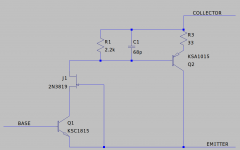I spend a lot of time modifying factory-built amps and preamps for better stability and lower distortion.
Sometimes we can drop in elements for better performance. The best example is replacing resistive current sources with "current regulating diodes." A worse example is using Darlington transistors in place of single bipolars. Darlingtons are no better than single bipolars, in terms of their parasitic Early effect and nonlinear Cob, so prepackaged Darlingtons are rarely useful in practice for modding.
Here's what I wish we could buy in a package and drop in, in place of a bipolar:
* Q1 is our "original" transistor
* J1 cascodes its base to eliminate Early effect and Cob
* R1 provides a close-to-constant bias current through Q1 so its Vbe won't vary much (high transconductance.) Any Vbe variance is nonlinear so we're happy to minimize it.
* R3 limits current gain across the whole "transistor" to a finite multiple of the hFE of Q1. That helps with stability, as does C1.
A semiconductor maker could package it up in a TO-92 and name it ("Cascopolar"?) and we could all design with it or mod existing circuits more easily. More likely: you could make a tiny PCB to assemble this on, and solder it in vertically in place of single bipolars.
Of course this presents some constraints that a single bipolar doesn't: collector current must stay above the bias current set by R1, and collector voltage must stay a few volts above the base to provide headroom for the cascode.
Sometimes we can drop in elements for better performance. The best example is replacing resistive current sources with "current regulating diodes." A worse example is using Darlington transistors in place of single bipolars. Darlingtons are no better than single bipolars, in terms of their parasitic Early effect and nonlinear Cob, so prepackaged Darlingtons are rarely useful in practice for modding.
Here's what I wish we could buy in a package and drop in, in place of a bipolar:
* Q1 is our "original" transistor
* J1 cascodes its base to eliminate Early effect and Cob
* R1 provides a close-to-constant bias current through Q1 so its Vbe won't vary much (high transconductance.) Any Vbe variance is nonlinear so we're happy to minimize it.
* R3 limits current gain across the whole "transistor" to a finite multiple of the hFE of Q1. That helps with stability, as does C1.
A semiconductor maker could package it up in a TO-92 and name it ("Cascopolar"?) and we could all design with it or mod existing circuits more easily. More likely: you could make a tiny PCB to assemble this on, and solder it in vertically in place of single bipolars.
Of course this presents some constraints that a single bipolar doesn't: collector current must stay above the bias current set by R1, and collector voltage must stay a few volts above the base to provide headroom for the cascode.
Attachments
A semiconductor maker could package it up
One more thing...
Manufacturers already have huge problems in a distributing discrete semis.
Most of talented designers now only in a huge IC designing companies, no investments in discrete market.
Even well known 2sk170/j74 was moved to Linear's factory.
So i'm hugely doubt in topic theme.
Good, but doubt.
